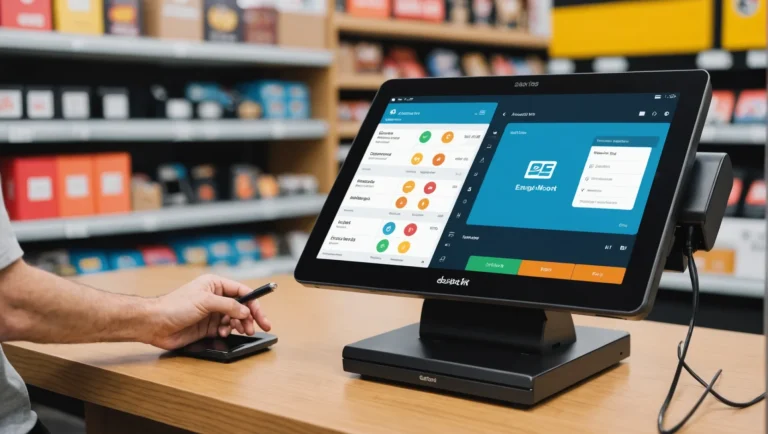Every second counts in retail.
A clunky POS system could cost you sales and customers.
From future payment technologies to advanced inventory management, we’ll cover it all.
Get ready to streamline your processes, boost security, and enhance customer experience.
This is your guide to staying ahead in 2025.
Metrobi drivers are rated 4.97/5
Trusted by local businesses for:
- Background-checked professionals
- Specialized in business deliveries
- Same drivers for consistency
- 4.97/5 average delivery rating
Retail POS System Features: Future Retail Payment Technologies
Digital wallets and contactless payments are leading the way forward.
Blockchain is enhancing transaction security and trust.
Traditional payment methods face competition from emerging technologies.
Embrace Digital Wallets and Contactless Payments
The Rise of Digital Wallets
Digital wallets have become central in the world of retail payments. Leading options like Apple Pay and Google Wallet streamline payment with speed and ease. In recent years, a mere 14% of UK transactions involve cash. This reveals a strong shift toward digital options. Even older demographics, such as 85 to 95-year-olds, have started using digital wallets, with 80% now making contactless payments. This is significant as it cuts across age groups and shows broad acceptability.
The benefits here extend beyond convenience. Digital wallets foster customer satisfaction by offering efficient and fast checkouts. But it’s not just about speed. Chris Bates, for example, underlines their essential role in making transactions more secure. As such, embracing digital wallets is not just about meeting current consumer demands. It’s about future proofing business against evolving market trends.
Contactless Payments: A Market Essential
Contactless payment is no longer a novelty. It’s an expectation. With digital wallets playing a large role in this area, businesses find themselves at an advantage. Faster transaction times lead to increased efficiency and customer satisfaction. Many retailers now prioritize this method. They recognize its role in keeping queues short and experiences smooth. Discover more about why payments without contact are quickly becoming the preferred method for transactions and how implementing this technology can elevate your business operations.
Blockchain-Inspired Security in Transactions
Overview of Blockchain Technology
Blockchain technology provides a decentralized ledger. It’s transparent and tamper-proof, which makes it appealing for POS system security. While commonly tied to cryptocurrencies, its potential in retail payments is vast. Companies like Starbucks, Burger King, and Microsoft have started accepting crypto payments, illustrating its expanding integration in everyday retail transactions.
One advantage of blockchain is its ability to minimize issues such as counterfeiting and theft. This doesn’t only protect businesses against losses; it builds customer trust. When customers feel secure, they are more likely to engage in digital transactions, and this engagement can deepen loyalty and repeat business.
Security and Trust
The primary goal is increased security. When customers know their data is safe, trust naturally flourishes. Blockchain’s role here can’t be understated. It mitigates risks associated with traditional cash handling, such as counterfeiting. As more businesses experiment with blockchain, customer experiences evolve to embrace security as a central feature.
Yet, not every business finds blockchain feasible despite its allure. High upfront costs and integration complexity can deter some. However, for businesses ready to embrace it, the rewards often outweigh the challenges.
The Broader Impact
While payment technologies advance, they create a ripple effect. More retailers integrating these innovations means better overall industry standards. Customers demand speed and security, with their expectations influencing retail approaches. Over time, traditional cash systems will likely feel the pressure to adapt or become obsolete.
Advanced Inventory Management Solutions
Gain complete control over stock levels with real-time updates.
Automate purchase orders to save time and reduce errors.
Understand the impact of these solutions through real business cases.
Real-Time Inventory Tracking
Importance of Real-Time Inventory Updates
Real-time inventory tracking is crucial for both small and large-scale retailers. Many retailers lose money every year due to stock discrepancies. By having an accurate understanding of stock levels, companies can reduce inventory errors. Real-time tracking helps manage every single SKU across multiple channels. This reduces the chances of stockouts and overstocks. Improved stock levels lead to better customer satisfaction, as items are available when needed.
Impact on Inventory Turnover
Real-time updates are not just about knowing what is on the shelves. They have a direct impact on financial performance. Faster inventory turnover means less money tied up in stock that isn’t selling. As turnover rates improve, carrying costs decrease. Real-time insights allow for smarter buying decisions and can significantly optimize supply chain strategies. Insights into past and future demand, as discussed by Logiwa, can help retailers better forecast needs and adjust for seasonal variations.
Automated Reordering Processes
Explanation of Automated Reordering
Automated reordering is a feature becoming essential in inventory management software. It allows employee management systems to automatically generate purchase orders when stock levels hit predetermined thresholds. This maintains adequate stock levels without manual intervention. By automating this process, retailers can reduce the risk of human error and ensure that stock is replenished promptly.
Minimizing Human Error
Manual reordering processes are prone to mistakes, from inaccurately estimating reorder quantities to completely forgetting to place an order. Automation minimizes such errors, leading to improved consistency and reliability.
Seamless Integration with Supplier Systems
Automation becomes truly powerful when integrated with supplier systems. Linking a business’s inventory management directly with suppliers ensures that orders are placed automatically with minimal delay. This is achieved through electronic data interchange (EDI) or advanced APIs, creating an uninterrupted supply chain. Integration facilitates direct communication between systems, without manual data entry which enhances order accuracy and fulfillment speed.
Enhance Seamless Customer Experience
Unified Omnichannel Experience
The Role of POS in Integrating Online and Offline Sales
POS systems now do more than just handle transactions. They link online and offline sales channels. A customer might research a product online, then buy it in-store; or check out items in-store and finalize the purchase online. The cloud based POS system stands in the middle of these actions. Handling inventory updates in real-time, customer data sync, and pricing consistency across platforms is crucial. For retailers, this extends reach and expands sales opportunities.
Ensuring Consistent Customer Experience Across Different Platforms
A seamless experience is vital. Whether customers engage online, through a mobile app, or in-store, they expect the same service. POS systems that synchronize these channels ensure customers receive consistent information, offers, and support. This synchronization mitigates issues like stockouts or price discrepancies. Consistency can lead to improved brand loyalty and increased customer satisfaction.
Personalization Features in POS Systems
How Customer Data is Used for Personalized Suggestions
POS systems gather and analyze vast amounts of data. This data—from buying histories to personal preferences—allows businesses to offer personalized product suggestions. The system recommends items based on a customer’s past purchases or browsing patterns. This leads to relevant promotions, enhancing the shopping experience and driving sales. Research supports personalization as a key factor in increasing customer satisfaction.
Increasing Sales Through Tailored Recommendations
Tailored recommendations aren’t just about selling more. They’re about offering genuine value to customers. Studies indicate that personalized experiences can boost sales by nearly 20%. When customers feel understood and valued, they’re more likely to make a purchase. This translates to more than just numbers—it fosters deeper customer connections.
Businesses That Have Successfully Personalize Their Offerings
Amazon is a prime example of personalized retail. Its recommendation engine accounts for 35% of total sales, showcasing the potency of personalization. Nordstrom uses advanced data analysis to tailor offers and promotions. These brands exemplify how turning raw data into actionable insights enhances customer engagement.
By examining these core aspects of customer experiences through POS systems, retailers can better position themselves to handle the evolving retail environment. This deep dive offers insights and a path for further learning into the intersection of technology and retail.
Data-Driven Decision Making Tools
Detailed Sales Analytics
Importance of Sales Data in Strategic Planning
Sales data is invaluable for making strategic choices. It helps businesses understand market trends and customer demands. By analyzing sales patterns, companies can predict future sales, identify which products are performing well, and make informed decisions on inventory restocking and marketing. These patterns highlight opportunities for growth and areas that might need attention.
Visualization Tools for Understanding Sales Trends
Visualization tools turn complex sales data into easy-to-understand visuals, making it accessible to decision-makers. These tools can showcase sales reports and trends over time, highlighting spikes or dips in sales, and allowing for rapid decision-making. Programs like Tableau or Power BI are widely used for their capability to create interactive dashboards, enabling users to filter data and uncover trends.
Visualization is crucial as it helps business leaders spot trends that may not be noticeable in raw data. By better understanding these trends, companies can rearrange their marketing efforts and inventory management to align with customer demands. Understanding how to use visualization tools will not only reveal current performance but will also help in setting measurable goals.
Real-World Impact of Analytics on Business Growth
The real-world application of sales analytics is evident in companies that have adopted a data-centric approach. Analytics not only highlights trends but also reveals gaps in the market. For example, retail giant Target utilized predictive analytics to identify purchasing patterns of loyal customers. Their study led to targeted marketing campaigns that significantly increased their market share.
This approach underscores that businesses which leverage data analytics can capitalize on untapped opportunities, ultimately leading to better market positioning and increased revenue. However, it’s important to acknowledge the challenges. Dependence on data analytics might sometimes lead to overlooking human intuition and creativity. But with the right balance, companies can achieve a synergy that fuels innovation.
Customer Behavior Insights
Utilizing POS Data for Understanding Customer Habits
POS systems gather invaluable data about customer behavior, offering insights into purchase habits and preferences. By examining this information, businesses can determine peak shopping times, the point of sale, preferred product categories, and even customer loyalty trends. Researchers like Philip Kotler in Marketing Management provide in-depth methodologies for dissecting consumer behavior data to better understand market demands.
Through POS data, companies can craft personalized marketing strategies that directly cater to their customer base. This is an opportunity not only to enhance customer satisfaction but to foster loyalty, which is key for long-term, loyalty management customers and business success.
Direct Applications of Behavioral Insights in Marketing
By understanding customer habits, businesses can create precisely targeted marketing campaigns. For instance, data showing customers’ regular purchases can lead to personalized offers or loyalty programs, encouraging repeat visits and increased sales. These insights also enable dynamic pricing strategies, adapting to real-time demand changes.
Marketing strategies that leverage customer data lead to higher engagement rates. A Harvard Business Review article noted that personalization can lead to a 10-15% increase in revenue for retailers who capitalize on behavioral insights. While powerful, it’s crucial to address consumer privacy. Ensuring transparent data collection methods and respecting customer privacy is not only ethical but also builds trust.
Success Stories of Businesses Leveraging Customer Data
Many companies have successfully harnessed customer data to drive growth. Starbucks, for instance, uses its loyalty app to gather detailed data about customer preferences, enabling them to tailor their offerings. This personalization has been a contributing factor to their global success, as noted in various case studies.
Implementing such strategies can be daunting. However, learning from success stories reveals common themes: strategic investments, skilled personnel, multi-store management, and a willingness to innovate. For retailers aiming to employ similar tactics, it is beneficial to review these case studies and examine whether similar techniques can be adapted to their business model.
Alternative POS Systems for 2025
Square POS
Easy setup and integration
In our hands-on experience, setting up the Square POS system was a breeze. Integration of sale system with existing platforms took less than an hour, making it ideal for businesses in need of a quick rollout. Enhance your sales efficiency with a portable POS solution, benefiting from the swift integration features similar to those of the Square system.
Features
Comprehensive reporting allows businesses to track sales trends and performance with ease, which proves essential for data-driven decisions.
Online store integration lets retailers synchronize their inventory with an e-commerce platform seamlessly.
Review
Feedback highlights Square POS’s user-friendly interface as a major plus, even for those who aren’t tech-savvy. It’s evident that Square prioritizes ease of use without compromising on functionality.
Toast POS
Geared towards restaurants and eateries
Toast POS tailors its service to food industry needs, focusing on menu flexibility and order management. During testing, its customized menu functions stood out, making it easier to adapt to menu changes on the fly. Discover how restaurant POS systems like Toast can enhance your service efficiency and guide you in choosing the ideal system for your establishment’s demands.
Features
Customizable menu options allow for instant updates, ensuring quick adjustments to item descriptions and prices.
Real-time reporting provides insights into daily performance, aiding in fast, informed decisions.
Review
Reviews frequently point to Toast POS’s adaptability in the restaurant sector. Its ability to cater to specific industry needs is a key reason for its high rating.
Pricing and feature overview
Toast POS offers tier-based pricing, allowing businesses to only pay for the features merchant services they need.
Shopify POS
Best for e-commerce and retail integration
Our tests showed Shopify POS excels in uniting online and offline sales. Its robust synchronization capabilities ensure consistent product and sales data across platforms. Discover the transformative power of Shopify’s point-of-sale system in harmonizing your digital and physical storefronts, enhancing operational efficiency and customer satisfaction.
Features
Seamless online store sync offers an integrated shopping experience that is crucial for businesses operating both physical and online stores.
Multi-channel sales management ensures efficient handling of sales from various platforms, reducing manual workload.
Review
Shopify the POS platform is praised for its strong e-commerce integration, especially handy for retailers expanding their reach beyond physical stores. The system’s agility in syncing multiple sales channels is lauded.
Supplementary Information
What is the Future of POS Software Business?
Evolution Towards Integrated Systems and Cloud-Based Solutions
Retail environments in 2025 are not static. They are swiftly moving toward integrated systems and reliance on cloud services. Traditional systems that involve standalone servers and databases are giving way to cloud-based solutions. These cloud systems offer flexibility, easy updates, and remote accessibility. Businesses can now streamline operations across branches without needing physical servers in each location. This shift to the cloud is fueled by the need for real-time data access and operations management in retail. The ubiquitous nature of the cloud will support the ever-rising consumer expectations for fast and seamless transactions.
Importance of Adapting to Emerging Technologies
Technological adaptation is crucial. Businesses that embrace new tech trends stay ahead in customer satisfaction and operational efficiency. Technologies like artificial intelligence, machine learning, and blockchain are finding their places in most POS systems. AI, for instance, can provide predictive analytics for stock and sales forecasts. Machine learning enhances personalized customer experiences by providing tailored recommendations based on buying patterns. Meanwhile, blockchain technology offers robust security, adding an extra layer of trust and transparency to transactions. As these technologies evolve, retail businesses need to maintain a forward-thinking approach to leverage their benefits fully.
Potential Developments in Software and Hardware
Software and hardware innovations in POS systems are evolving rapidly. Future advancements may include expanding mobile POS solutions and developing software that can provide real-time operational insights on a single dashboard. On the hardware side, biometric verification methods might become more common, enabling transactions authenticated by users’ fingerprints or facial recognition. Another potential development might be integrated augmented reality (AR) for customer engagement. These could create interactive retail experiences directly tied to the POS system. Keeping an eye on these potential advancements will prepare businesses for a seamless transition as newer technologies emerge.
Essential Features of a POS System
Core Functionalities: Payment Processing and Inventory Tracking
At the heart of any POS system are integrated payment processing and inventory tracking. Efficient payment processing ensures fast and secure transactions, vital for customer experience and checkout speed. It’s crucial that POS systems can handle multiple payment types, including credit/debit cards and mobile payments like Apple Pay or Google Wallet. Inventory tracking is equally important. It allows businesses to monitor stock levels in real time, ensuring they meet customer demand without overstocking. This balance aids in reducing carrying costs and optimizing shelf management. A robust POS system combines both to improve operational efficacy. Delve deeper into mastering payment processing in a retail environment with our extensive guide, and provide your customers with seamless transaction experiences.
Importance of User-Friendly Interfaces and Customization
User-friendly interfaces are essential. They minimize training time for staff and reduce errors during transactions. A simple, intuitive interface allows employees to focus more on customer service rather than navigating complex systems. Customization is another key feature. Each business has unique processes, and a POS system should adapt to these needs rather than forcing a set workflow. Customization options can include tailored reporting tools, unique pricing schemes, or personalized staff roles and permissions. A flexible system supports businesses in creating processes that boost productivity and customer satisfaction.
Necessary Security Measures for Protecting Data
With increased digital transactions, protecting sensitive data has become paramount. POS systems must have advanced, security features and protocols to safeguard customer and business data. Encryption is vital to ensure all transactions are protected. Regular software updates keep systems resilient against new threats. Also, implementing tokenization can further secure transactions by replacing sensitive information with unique tokens. Businesses should also look into routine security audits and compliance with standards like the Payment Card Industry Data Security Standard (PCI DSS). A secure POS system builds trust and mitigates risks associated with data breaches.
Selecting the Best POS System for Your Business
Considerations: Industry Specific Needs, Budget, Scalability
Selecting a POS system is not a one-size-fits-all process. Different industries have distinct requirements. For instance, restaurants might need features like table management or custom tipping options, while retail stores may prioritize inventory management and barcode scanning. Budget plays a significant role. It’s essential to consider both upfront costs and ongoing fees to ensure financial sustainability. Scalability is another critical factor. A business needs a system that can grow alongside it, offering additional features and services as required. Balancing these considerations helps in making an informed choice. For an informed decision-making process, dive into our comprehensive comparison of different POS systems to discover the perfect option that meets your specific business requirements.
Evaluating Customer Support and After-Sales Service
Customer support shouldn’t be an afterthought. It is crucial to evaluate the support provided by the POS vendor. This includes assessing whether they offer 24/7 support, how accessible their helpdesk is, and if they provide robust training materials. After-sales service can include software updates or maintenance packages for any technical issues that arise. A vendor’s responsiveness in addressing potential problems could be the difference between a minor hiccup and a business-disrupting issue. Prioritizing a vendor with excellent customer support ensures peace of mind, knowing that help is available when needed.
The Significance of Trial Versions and Demos in the Selection Process
Trying before buying can save businesses from making costly mistakes. Trial versions or demos can provide insights into a system’s functionality. These trials offer an opportunity to test usability, see how the system integrates with existing operations, and identify potential issues before fully committing. They are also a chance to evaluate the features a business requires versus what is available. A hands-on experience allows businesses to gauge whether the point of sale system aligns with their workflow and expectations. Implementing a POS demo helps make an informed purchasing decision.
Stepping into the Future of Retail POS
Embracing digital wallets and contactless payments while utilizing blockchain-inspired security takes center stage in retail. Advanced inventory tools ensure efficiency and create seamless experiences for your customers. Data-driven insights empower strategic decisions. Exploring the optimal POS system for your small venture? Our detailed guide assists in navigating towards the perfect fit.
You should make a move towards integrated omnichannel systems and real-time inventory tracking. It is better to consider evaluating mobile POS systems and options like Square, Toast, and Shopify based on your industry needs.














